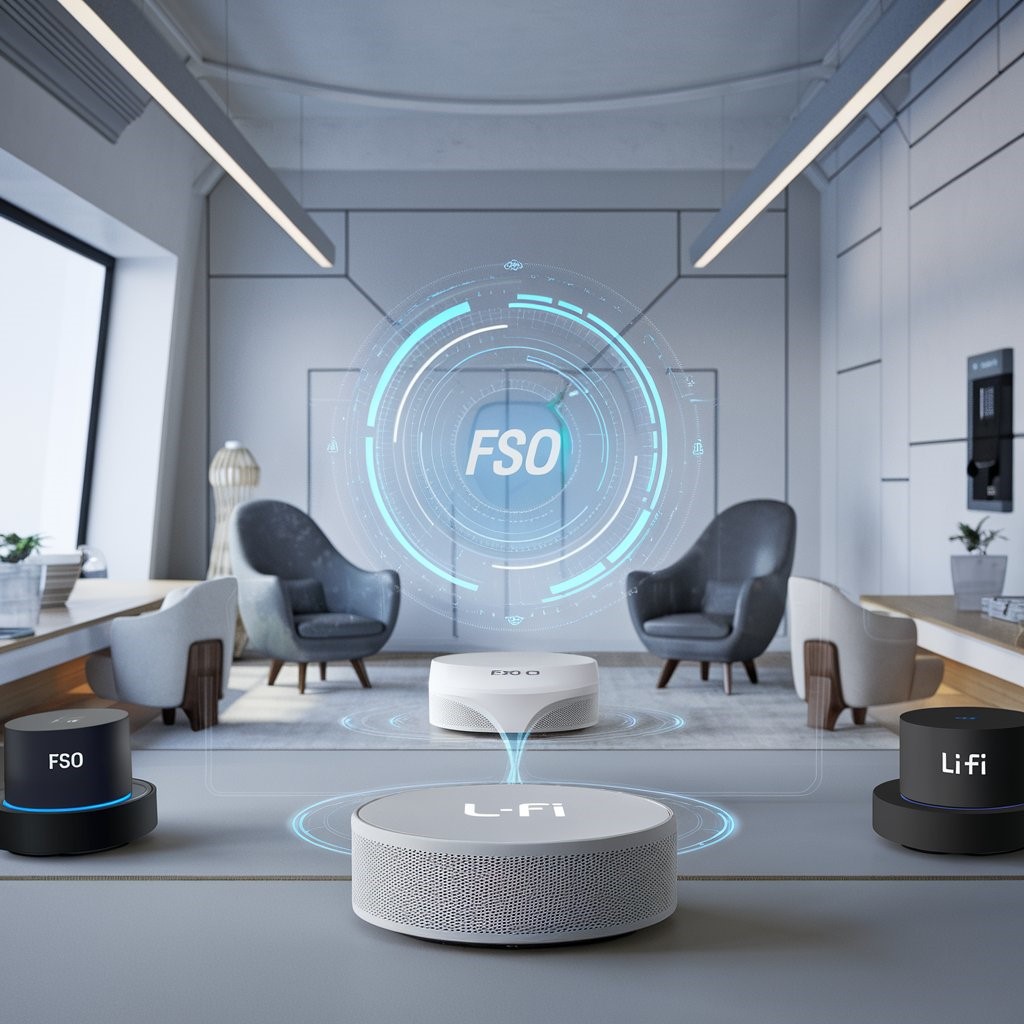In today’s digital era, the need for faster and more reliable data transmission is greater than ever. As businesses, governments, and individuals continue to demand high-bandwidth solutions for applications ranging from internet connectivity to communication systems, traditional wired solutions often fall short. Enter Free Space Optics (FSO), an innovative technology that is poised to revolutionize high-speed data transmission.
FSO uses light to transmit data through the air, offering a wireless alternative to fiber optics that can provide ultra-fast, secure, and efficient communication. The technology operates by modulating light in the infrared or visible spectrum and transmitting it across free space, which means it does not require any physical medium like cables. As this technology gains traction, it is set to reshape how we think about and use data transmission, particularly in urban environments, remote locations, and across long distances.
Understanding Free Space Optics (FSO) Technology
Free Space Optics (FSO) is an optical communication system that uses light to transmit data over free space—hence the name. Unlike conventional communication methods like Wi-Fi or cellular networks, FSO does not rely on radio frequencies or wires. Instead, it utilizes light (typically infrared light) to send information across line-of-sight paths between transmitters and receivers.
Key components of an FSO system include:
- Transmitter: This is the light source (usually an LED or laser) that encodes the data and transmits it as light waves.
- Receiver: A photodetector or photodiode that captures the transmitted light and converts it back into the digital information.
- Free Space Path: The medium through which the light travels, such as the air or the vacuum of space, with the data being transmitted across the line-of-sight.
Because FSO technology is based on light transmission, it can achieve extremely high data transfer rates, far surpassing traditional radio-frequency (RF) communications like Wi-Fi and LTE networks. Moreover, because light waves are not prone to interference from common RF sources, FSO technology offers a more secure and stable form of communication.
The Growing Demand for Free Space Optics (FSO)
The demand for FSO technology has grown significantly in recent years due to several key factors:
1. Increasing Need for High-Speed Internet
With the explosion of data consumption globally, especially in the fields of cloud computing, video streaming, and Internet of Things (IoT) applications, the need for faster internet connectivity is at an all-time high. FSO technology can deliver high-speed internet connectivity in areas that are challenging to reach with traditional fiber optics or wired systems. It offers a viable solution for providing high-bandwidth communication, particularly in urban and remote locations where it may be cost-prohibitive to lay physical cables.
2. Bandwidth Limitations of Traditional Wireless Systems
Radio-frequency communication systems such as Wi-Fi and cellular networks are increasingly congested due to limited available spectrum. This congestion leads to slower speeds and higher latency, particularly in densely populated areas. FSO, on the other hand, operates in the optical spectrum, which is largely unregulated and underutilized, enabling the potential for much higher bandwidths.
3. Growing Demand for Secure Communications
With the rise of cybersecurity threats and concerns about data privacy, organizations are looking for secure alternatives to traditional wireless communication methods. Since FSO is highly directional and does not pass through walls or obstacles, it is inherently more secure than RF-based communication systems. Data transmitted using FSO is less susceptible to interception or eavesdropping, making it an attractive option for governments, defense organizations, and financial institutions.
4. Enhancing Connectivity in Remote and Rural Areas
A key benefit of FSO technology is its ability to provide high-speed internet access in remote, rural, or hard-to-reach locations. In these areas, the cost of laying physical fiber optic cables can be prohibitive. FSO offers a more affordable alternative, providing fast and reliable communication systems without the need for extensive infrastructure.
The FSO & VLC/ Li-Fi market was valued at USD 2.78 billion in 2024 and is projected to reach USD 7.39 billion by 2029, growing at a CAGR of 21.6% from 2024 to 2029. The primary factor driving the growth of VLC/Li-Fi market is the faster and safer data transfer
Download PDF Brochure @ https://www.marketsandmarkets.com/pdfdownloadNew.asp?id=946

Key Applications of FSO Technology
The versatility of FSO technology makes it suitable for a wide range of applications. Below are some of the most promising use cases:
1. Telecommunication and Broadband Connectivity
FSO can play a crucial role in providing last-mile connectivity for broadband networks. It can deliver high-speed internet to homes and businesses, especially in locations where traditional broadband infrastructure is unavailable or difficult to install. By using FSO links between base stations and customer premises, telecommunication providers can offer fast and reliable internet access.
2. Military and Defense
FSO technology has significant applications in the military and defense sectors. Given its highly secure nature, it is used for secure data transmission in sensitive areas, where radio-frequency communication could be intercepted or jammed. FSO systems are also ideal for tactical communication on the battlefield and for connecting remote military bases.
3. Satellite Communication
FSO can be used to enhance satellite communication systems by providing high-speed data links between satellites and ground stations. In space, the use of FSO technology can support large data transfers at higher speeds than traditional radio-frequency communication, making it ideal for applications like global internet access and satellite imaging.
4. Smart Cities
FSO is a critical component in the development of smart cities, where efficient data transmission is required for the operation of various systems such as smart grids, traffic management, and public safety. FSO can help connect infrastructure, such as streetlights, traffic cameras, and sensors, to create seamless communication networks that improve city services and living conditions.
5. Healthcare and Remote Monitoring
In healthcare, FSO can provide reliable communication networks for telemedicine and remote patient monitoring, where low-latency and secure data transmission is essential. It can be particularly useful in medical facilities with sensitive equipment that needs to be shielded from electromagnetic interference, which can affect traditional wireless systems.

Challenges and Limitations of FSO Technology
While FSO holds great promise, there are several challenges that need to be addressed for its widespread adoption:
- Line-of-Sight Requirement: FSO requires a clear line of sight between the transmitter and receiver, making it vulnerable to obstruction by weather conditions, buildings, or other physical obstacles.
- Weather Sensitivity: Fog, rain, and snow can affect the reliability of FSO links. Poor weather conditions can cause signal attenuation, reducing the data transmission range and reliability.
- Limited Range: The effective range of FSO technology is currently limited by the power of the light source and the atmospheric conditions. However, advances in light modulation and the use of higher-powered lasers are expected to improve the range.
The Future of FSO Technology
Despite its challenges, the future of FSO technology looks bright. With the growing need for fast, secure, and reliable wireless communication, the market for FSO is expected to expand significantly. Companies are investing in research and development to overcome current limitations, including improving the resilience of FSO systems to weather conditions and expanding the technology’s range.
The FSO market is likely to see further growth across various sectors, including telecommunications, defense, smart cities, and healthcare, driven by the need for high-speed internet and secure communication solutions. As FSO technology continues to mature, it may become an integral part of global communication infrastructure, complementing traditional wireless systems and providing faster, more reliable connectivity to millions of people worldwide.
The Free Space Optics (FSO) market is positioned to revolutionize high-speed data transmission, offering an innovative solution to the growing demand for faster, more secure wireless communication. With its ability to provide high-bandwidth, low-latency communication over long distances, FSO technology has vast potential in a wide range of industries. As advancements in FSO systems continue, this technology is expected to play a key role in shaping the future of global connectivity. Whether for telecommunications, military defense, satellite communications, or smart cities, FSO is on track to be a game-changer in the world of wireless communication.
